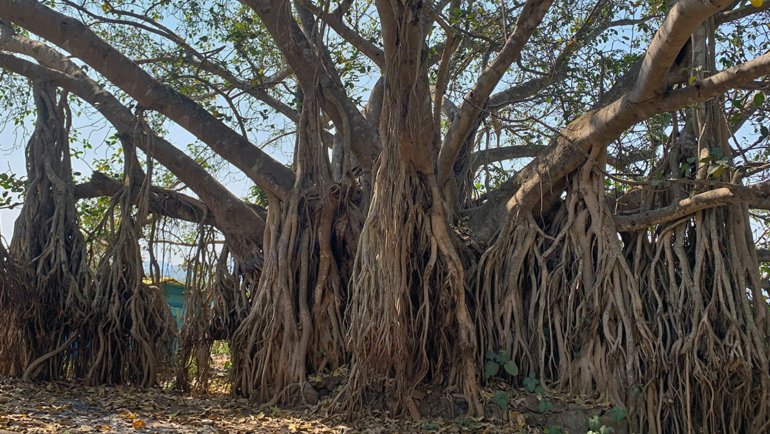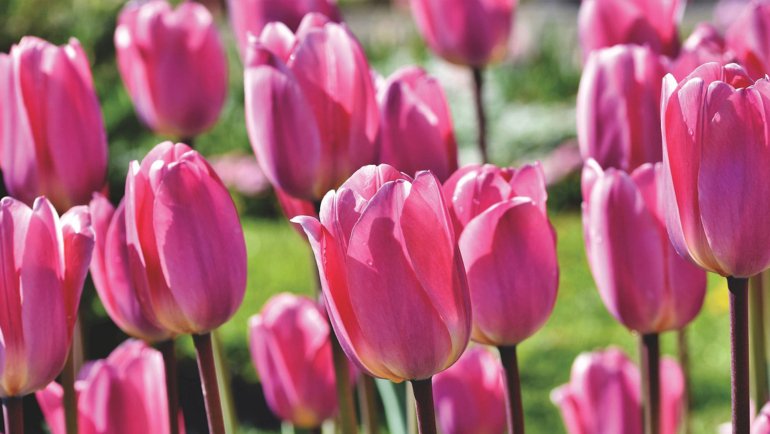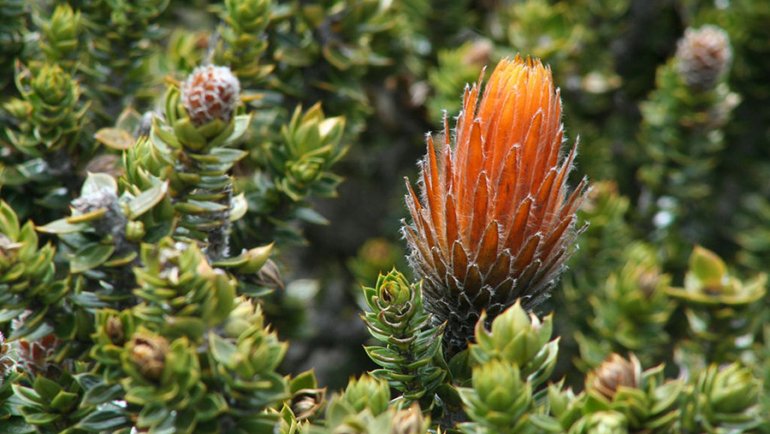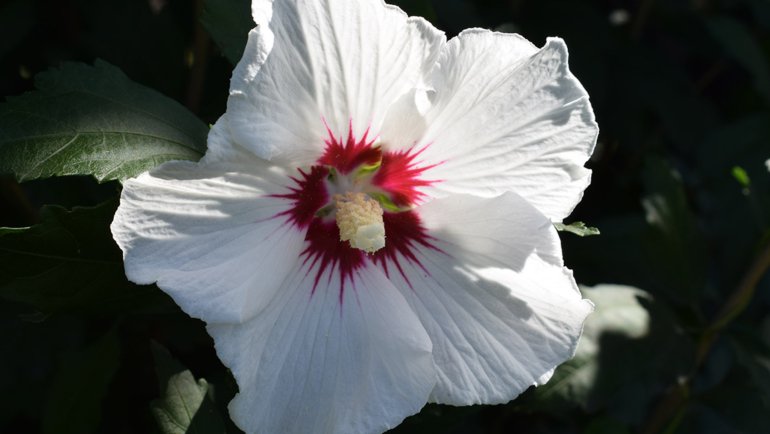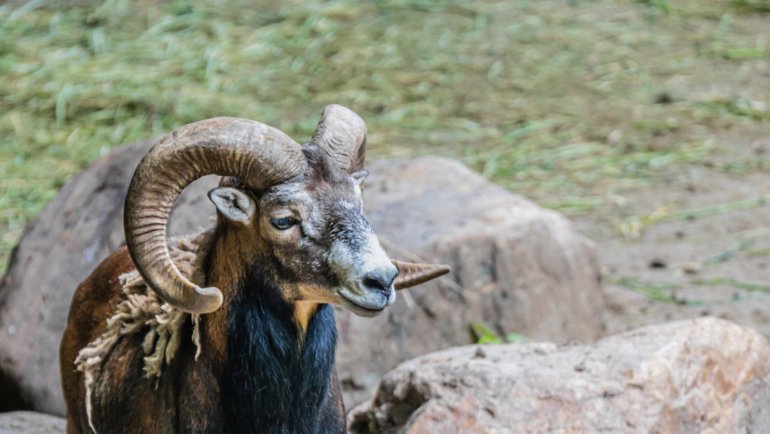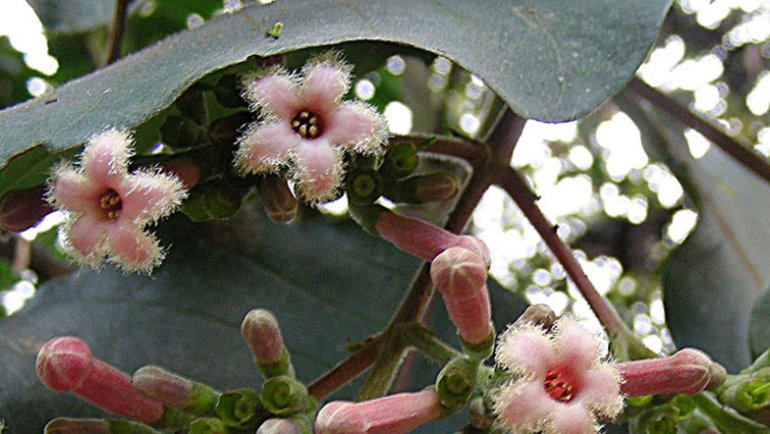High above the picturesque landscapes of Nepal, amidst the towering peaks of the Himalayas, blooms a vibrant symbol of the nation’s heart: the Rhododendron arboreum.
Commonly known in the local dialect as ‘Lali Gurans’, this magnificent flower captivates locals and tourists alike, telling a story that’s as old as the mountains themselves. As you immerse yourself in the rich diversity of Nepal’s flora, take a moment to understand the tale of this national treasure and its deep roots in Nepali culture.
Description of The Rhododendron arboreum
Rhododendron arboreum, or as it is endearingly called, the “rhododendron tree,” belongs to the extensive Rhododendron genus, which boasts over a staggering 1,000 species. Native to the Himalayan expanse, the tree paints a picturesque backdrop against the snow-clad peaks. Its robust trunk, intricate branches, and leathery leaves all speak of its endurance and timeless beauty.
As spring graces the region, the Rhododendron arboreum bursts into life, adorning itself with bell-shaped flowers. These blossoms, which can be white, pink, or a dazzling red, become nature’s very own festival of colors, signifying the rejuvenation that spring brings.
While many species in the Rhododendron genus are majestic in their stature, often reaching 40 to 60 feet in the wild, Rhododendron arboreum outshines them all. A testament to its grandeur, a specimen measured on Mt. Jabfu in India in 1993 stood at a staggering 108 feet (33 m)!
The bloom season for this majestic tree is a sight to behold. As winter retreats and gives way to the warmth of spring, from March to May, the hillsides of Nepal transform into a red sea of blossoms, making it a mesmerizing spectacle for all who visit.
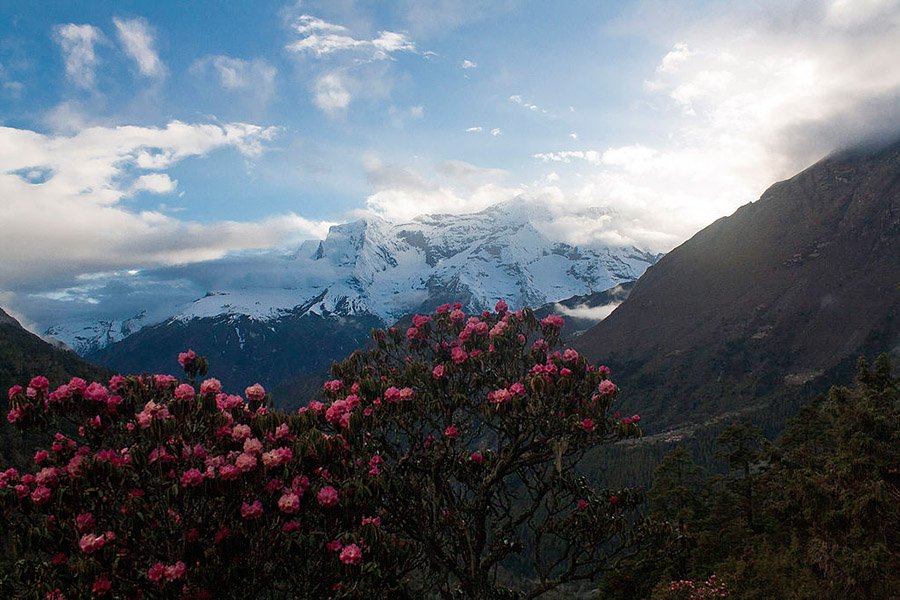
Where Does The Rhododendron arboreum Grow?
The Rhododendron arboreum thrives in the serene and rugged terrains of the Himalayas. Within Nepal, these magnificent trees bloom at elevations ranging from 5,000 to 13,000 feet (1,500 to 4,000 m) above sea level, where the cool mountain air and misty landscapes offer the perfect sanctuary.
It’s not just the altitude that this flower loves; the region’s unique combination of well-drained soils, seasonal rainfall, and moderate temperatures provides an ideal environment for its growth.
While Nepal proudly wears the title of home to the Lali Gurans, the rhododendron tree doesn’t limit itself to the country’s borders. This resilient flower has rooted itself across Southeast Asia, adorning the landscapes of northern India, south and western China, Myanmar, Pakistan, Thailand, and other neighboring territories.
Each region offers a slightly different climate and soil composition, yet the Rhododendron arboreum adapts and flourishes, proving its versatility and tenacity.
The Rhododendron arboreum in The Ecosystem
Beyond its aesthetic appeal, the Rhododendron arboreum plays a crucial role in its ecosystem. The lush canopies and dense foliage offer shelter to various bird species, such as the sunbirds and flowerpeckers, which often nest amidst its branches.
Furthermore, its nectar-rich flowers are a sought-after treat for various pollinators, including bees and butterflies, ensuring the continued proliferation of not just the Rhododendron but also other plants in the region.
The fallen leaves and petals of the Rhododendron arboreum enrich the soil, contributing to its fertility and ensuring that the region remains a thriving hotspot of biodiversity. Several herbivores, particularly in the Himalayan region, graze on the young shoots and leaves, making the tree a food source as well.
Moreover, the presence of these trees on mountain slopes aids in soil stabilization. Their extensive root systems prevent soil erosion, especially during the monsoon rains, safeguarding the habitats of various other plants and creatures in the vicinity.
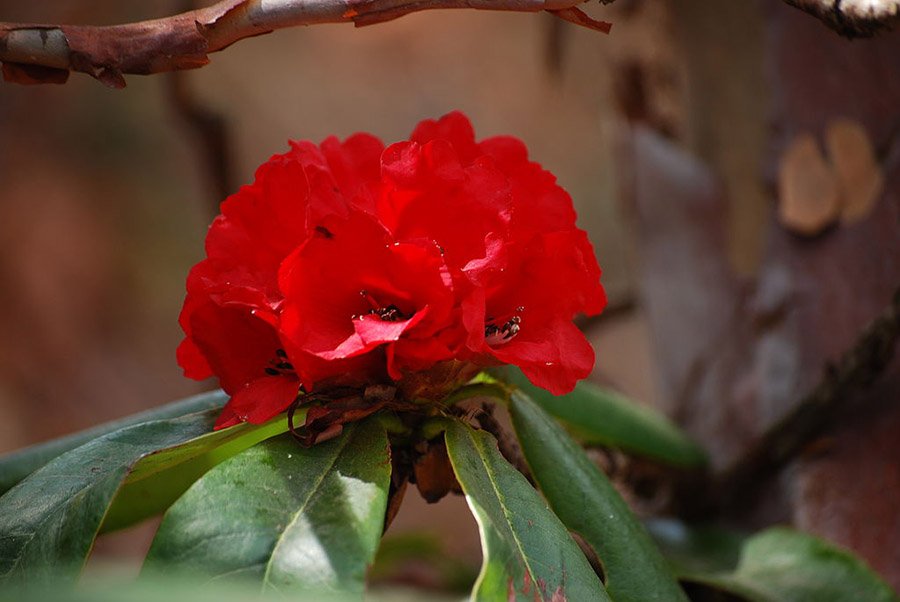 Source: Wikimedia Commons
Source: Wikimedia CommonsSymbolism and Meaning: Why and When Did The Rhododendron arboreum Become the National Flower of Nepal?
The Rhododendron arboreum, locally celebrated as Lali Gurans, is more than just a plant in Nepal. It’s a symbol, a living testament to the nation’s rich cultural and natural heritage. The bright scarlet hue of its blossoms evokes a sense of passion, vitality, and resilience, mirroring the spirit of the Nepali people.
But when did this reverence begin? While the rhododendron trees have been an intrinsic part of the Himalayan backdrop for eons, it was only in 2019 that the Rhododendron arboreum was officially declared the national flower of Nepal.
The decision, however, was a mere formality. For generations, this flower has been deeply intertwined with Nepal’s identity, signifying purity, beauty, and the harmony of nature with mankind.
Beyond its visual appeal, the Rhododendron arboreum holds religious significance among the Nepali people. Regarded as sacred, its vibrant blossoms are frequently used as offerings in temples, acting as a conduit between the divine and the earthly.
Every spring, as the hills and mountains are painted with a riot of red, the local populace embarks on pilgrimages to witness this natural spectacle, further solidifying the bond between man, nature, and the divine.
Where is The Rhododendron arboreum Featured in Nepal?
A flower of such stature inevitably finds its way into various facets of Nepali life. While it might not flutter on the country’s flag, the radiant red blossoms of the Rhododendron arboreum proudly grace Nepal’s national currency. This inclusion not only reflects the flower’s significance but also serves as a reminder of the nation’s commitment to preserving its natural beauty.
Beyond monetary representation, the Lali Gurans is a popular motif in Nepali folk art, often depicted amidst serene Himalayan backdrops, capturing the essence of the nation’s landscapes. During festive times, it’s not uncommon to see women and girls decorating their hair with these blossoms, adding a touch of nature’s elegance to their attire.
In the diplomatic arena, Nepal offers Rhododendron arboreum specimens to other nations, a gesture symbolizing goodwill, friendship, and the shared aspiration for peace and harmony.
Names of The Rhododendron arboreum
While widely recognized as Rhododendron arboreum in botanical circles, this flower boasts a myriad of names reflecting its wide distribution and cultural significance. In Nepal, it’s fondly referred to as “Lali Gurans”, translating to “red rhododendron”.
This endearing name captures the flower’s vibrant hue and its place in the hearts of the Nepali people. Its other epithet, the “rhododendron tree,” hints at its impressive stature, distinguishing it from its many smaller relatives.
Across its range, it’s not uncommon for local dialects to have their own names for this iconic plant. For instance, in parts of northern India, it might be known under different vernacular names.
Additionally, the botanical community occasionally recognizes synonyms in the flower’s nomenclature, a testament to its widespread study and significance.
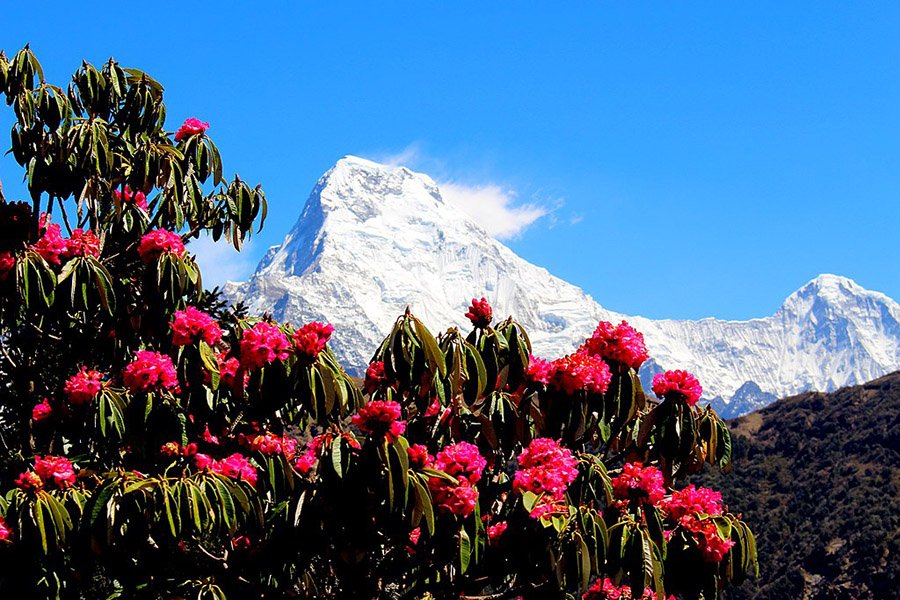 Source: Wikimedia Commons
Source: Wikimedia CommonsInteresting Facts About The Rhododendron arboreum
- A Giant Among Giants: While many plants in the Rhododendron genus achieve impressive heights, the arboreum species stands out. A specimen discovered in 1993 on Mt. Jabfu in India astonishingly reached 108 feet (33 m)! It is recognized as a world record by the Guinness World Records.
- Medicinal Marvel: Beyond its aesthetic allure, Rhododendron arboreum is prized for its medicinal properties. Traditional remedies and herbal teas made from its parts are believed to possess healing attributes.
- A Stamp of Approval: Such is the flower’s significance that the Indian Postal Service has issued special stamps commemorating it, further cementing its place in South Asian culture.
- A Riot of Colors: Though the scarlet variant is the most famous, Rhododendron arboreum can bloom in white and pink shades, offering a mesmerizing palette in the wild.
How to Grow The Rhododendron arboreum
If you’ve been enchanted by the Lali Gurans and wish to cultivate it, here are some guidelines:
- Soil Requirements: Well-draining, acidic soil is ideal. A pH level between 4.5 and 6 is optimal. Enriching the soil with organic compost can boost its health.
- Sunlight Needs: While they appreciate sunlight, it’s best to plant them in a location where they can receive dappled shade, especially during the intense afternoon sun.
- Watering: Regular watering is essential, especially during dry periods. However, avoid waterlogging the soil as this can harm the plant.
- Elevation: In their natural habitat, they thrive at elevations between 6,500 and 13,000 feet. While it’s challenging to replicate this in gardens outside this range, ensuring cool, temperate conditions can help in their growth.
- Pruning: Regularly pruning the plant helps in maintaining its shape and removing dead or diseased parts.
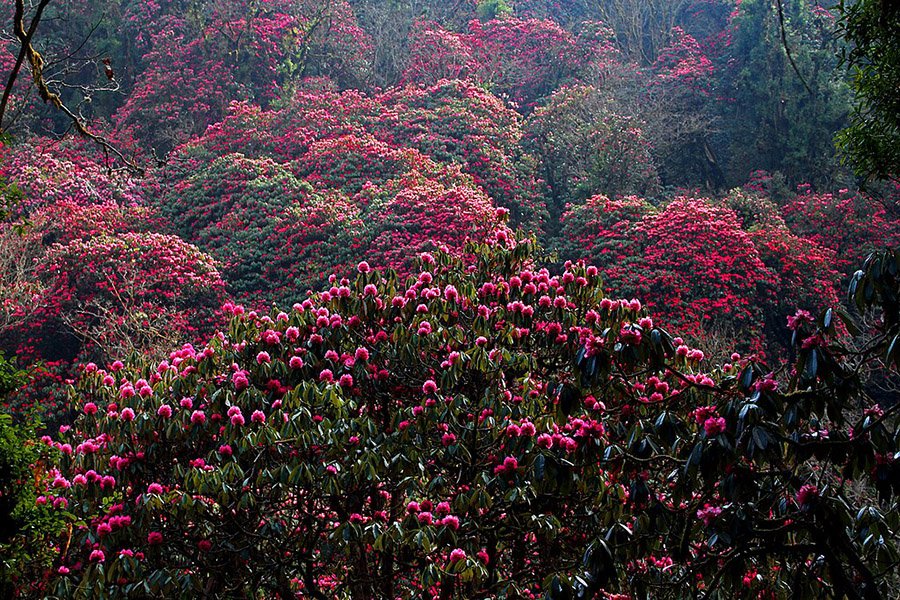 Source: Wikimedia Commons
Source: Wikimedia CommonsOther Beautiful Flowers Found in Nepal
Nepal, nestled within the towering peaks of the Himalayas, is a treasure trove of botanical wonders. Here are five other native flowers that capture the essence of this mesmerizing land:
- Daphne (Daphne bholua): This winter bloomer is not just known for its white or pink flowers, but also for the aromatic scent they release. Its bark is used to make traditional Nepali paper.
- Himalayan Blue Poppy (Meconopsis grandis): A true spectacle, this flower sports a radiant blue hue and usually grows in the higher altitudes of the Himalayas.
- Himalayan Edelweiss (Leontopodium himalayanum): Often associated with the Alps, Edelweiss also finds its home in the Himalayas of Nepal. Its star-shaped white flowers are a symbol of rugged beauty.
- Orchids: Nepal boasts an impressive variety of orchids, thanks to its diverse topography. From tropical to alpine regions, these flowers paint the landscape with their unique colors and shapes.
- Sunakhari (Rhynchostylis retusa): A popular orchid in Nepal, Sunakhari is revered not just for its beauty but also its use in traditional medicines.
Frequently Asked Questions
When was the Rhododendron arboreum declared the national flower of Nepal?
The Rhododendron arboreum was declared the national flower of Nepal in 2019.
Can the Rhododendron arboreum be found outside of Nepal?
Yes, it grows in several countries in the Himalayan region and Southeast Asia, including China, India, Myanmar, Pakistan, and Thailand.
Is it true that the Rhododendron arboreum can grow over 100 feet tall?
Yes, the tallest recorded specimen was found on Mt. Jabfu in India in 1993, measuring an astonishing 108 feet or 33 meters!
Are there any medicinal uses for the Rhododendron arboreum?
Absolutely. In addition to being aesthetically pleasing, the flower and other parts of the plant have been used for traditional remedies and in herbal teas.
Are there other colors of the Rhododendron arboreum apart from red?
Indeed, while the red variant (lali gurans) is the most renowned, the flower can also bloom in white and pink shades.
